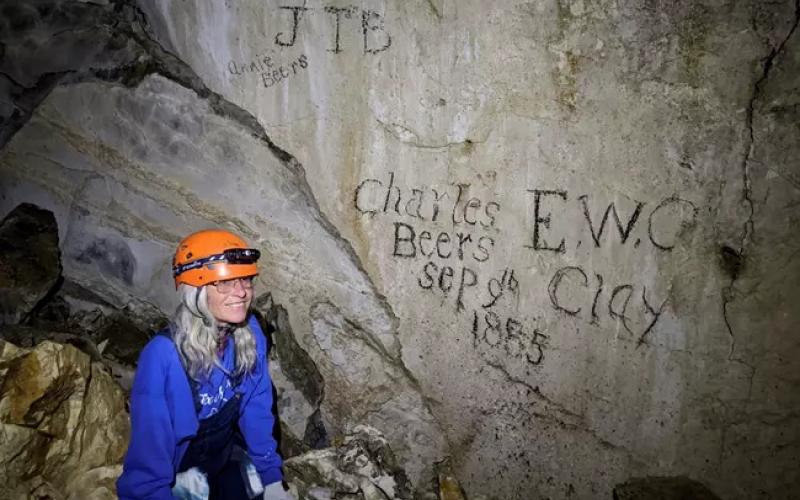The Midden: Human Connections with Historic Cave Inscriptions

This article is the second in a series of posts showcasing articles published in the Winter 2023 issue of “The Midden”, Great Basin National Park’s semiannual resource management newsletter. The series will introduce you to some of the issues, projects, and management strategies currently happening in Great Basin National Park.
People have been writing names and dates in Lehman Caves since 1885. Meet the families of two early visitors to the cave who help shed some light on what it might have been like to visit the cave back then.
Human Connections with Historic Cave Inscriptions
By Gretchen Baker, Ecologist/Cave Specialist
Some early visitors to Lehman Caves left their mark in the cave. Over 2,000 historic inscriptions are found in many passages and rooms. These inscriptions create a bridge with the past. Two groups came in 2023 to visit and learn more about inscriptions their ancestors left. (Note: writing on cave walls these days is considered graffiti and violates the Federal Cave Resources Protection Act.)
In the back part of the cave, in the Talus Room, prominent inscriptions from the year 1885 show the names Charles Beers and Annie Beers. One of the descendants of the Beers Family, Kristi Nuttall, asked to visit these inscriptions. The Park had very little information about who these people were and why they had visited the cave. On June 6, 2023, Kristi visited with the Park’s cave specialist, archaeologist, and an interpretive ranger.
What we learned from Kristi's visit is that Annie Beers was born in December 1860, so she was 24 years old when she visited the cave on September 9th, 1885, with her husband, James Thomas Beers (initials JTB above hers in the cave). They came from Frisco, Utah, where they operated the Frisco Stage Line to a little town called Las Vegas, Nevada. James's brother Charles came with, along with the editor of the Southern Utah Times, who was probably Charles King. The person who led the group was EWC Clay, Justice of the Peace. There may have been other party members, as we've seen another inscription from that date in another part of the Talus Room, but on the "Billboard," those are the folks who left their mark.
It's fun to imagine how they came out from Frisco, what made them decide to visit the cave, and how they traveled through it. 1885 was the first year that Lehman Caves was open for visitation, so the trails would have been rudimentary, with ladders to get in the cave and over obstacles, and a belly crawl through Fat Man’s Misery. Kristi left a copy of their family history with the Park.
In 1934, Reverend Takeshi Ban traveled to Lehman Caves. He left an inscription in Japanese in the Lake Room, which you can see below and on this call-out video on Inscriptions that is part of the Lehman Caves Virtual Cave Tour: Inscriptions - Youtube
The Inscription, in Japanese, translated reads:
June 23, 1934
Muranaka Eiichi
Tsujimoto Seitaro
Ban Takeshi
Ban Kazutaro
At this time (Sept 1933-May 1936) Reverend Takeshi Ban was the Dean of the Japanese Department at the Los Angeles Pacific College. He visited the cave in June, which was likely summer break for the college. One of the other members of the group in the cave was Muranaka Eiichi, the leader of a Japanese group of copper miners living in Ruth, Nevada. So it was likely Rev. Ban was visiting the Japanese group in Ruth and they decided to make a trip over to Lehman Caves.
While the Park was preparing for the Virtual Cave tour, park archaeologist Joanie Lombardi went to a conference and made a connection with the archaeologist at Manzanar, and they realized that Takeshi Ban who left the inscription in the cave had also been at Manzanar. Joanie reached out to the family and got more information, some of which is shared in the YouTube video. Descendants of Reverend Takeshi Ban started making plans to come visit the inscription in the cave. But then came Covid, and the trip was delayed for years. Finally, in September 2023, six family members made it to Lehman Caves.
The family shared that Rev. Takeshi Ban had ties with three national park areas. He set up the Japanese Congregational Church in Puna, Hawaii, near Hawaii Volcanoes in 1912. He later left the inscription in Lehman Caves National Monument, then was interred in what is now Manzanar National Historic Site. The extended family has visited these locations to learn more about this influential family member. Lisa Yee, a relative, said during their visit to Lehman Caves, "To follow in his footsteps has been such a blessing."
Rev. Takeshi Ban was born on July 3, 1884 and died in February 1956. He would have been about 50 years old when he visited Lehman Caves in 1934. At that time, visiting the cave was a bit different than today. There were no entrance and exit tunnels, so he would have had to climb the hill up to the cave entrance, then descend on steep wooden stairs into the cave. There was no lighting system, so he would have had to bring his own light. There were no paved trails, so footing would have been more uneven. Some of the passages (like the Rocky Road) may have been smaller. Most likely the Lake Room was dry during his visit, as it is most of the time.
It's fun to imagine what earlier visitors to the cave saw and experienced. We're grateful to the Beers and Ban family descendants for sharing their perspective and helping us have a deeper understanding of the cave.
Photo: Kristi Nuttall in Lehman Caves with the Beers inscriptions nearby. NPS/G. Baker
